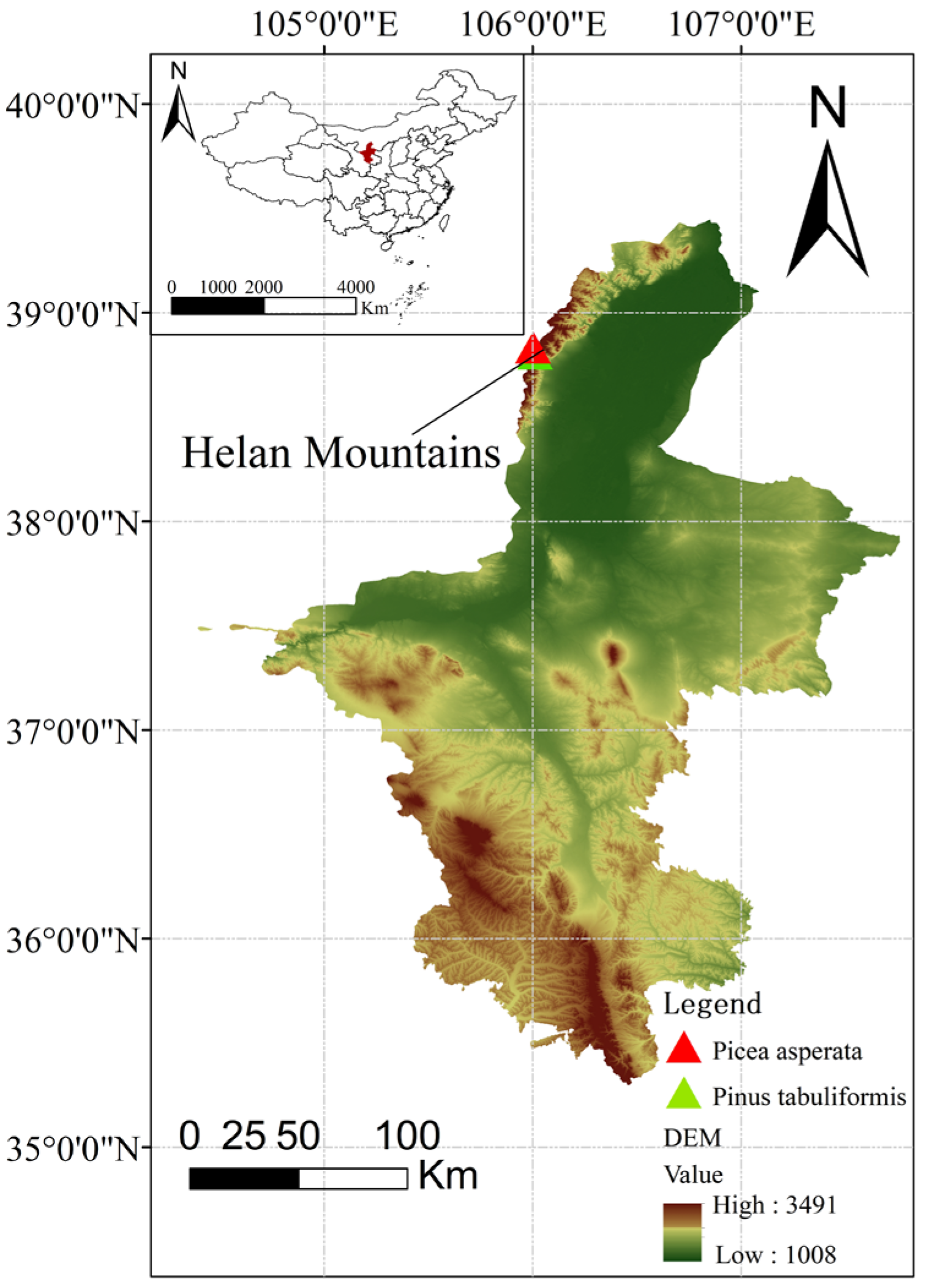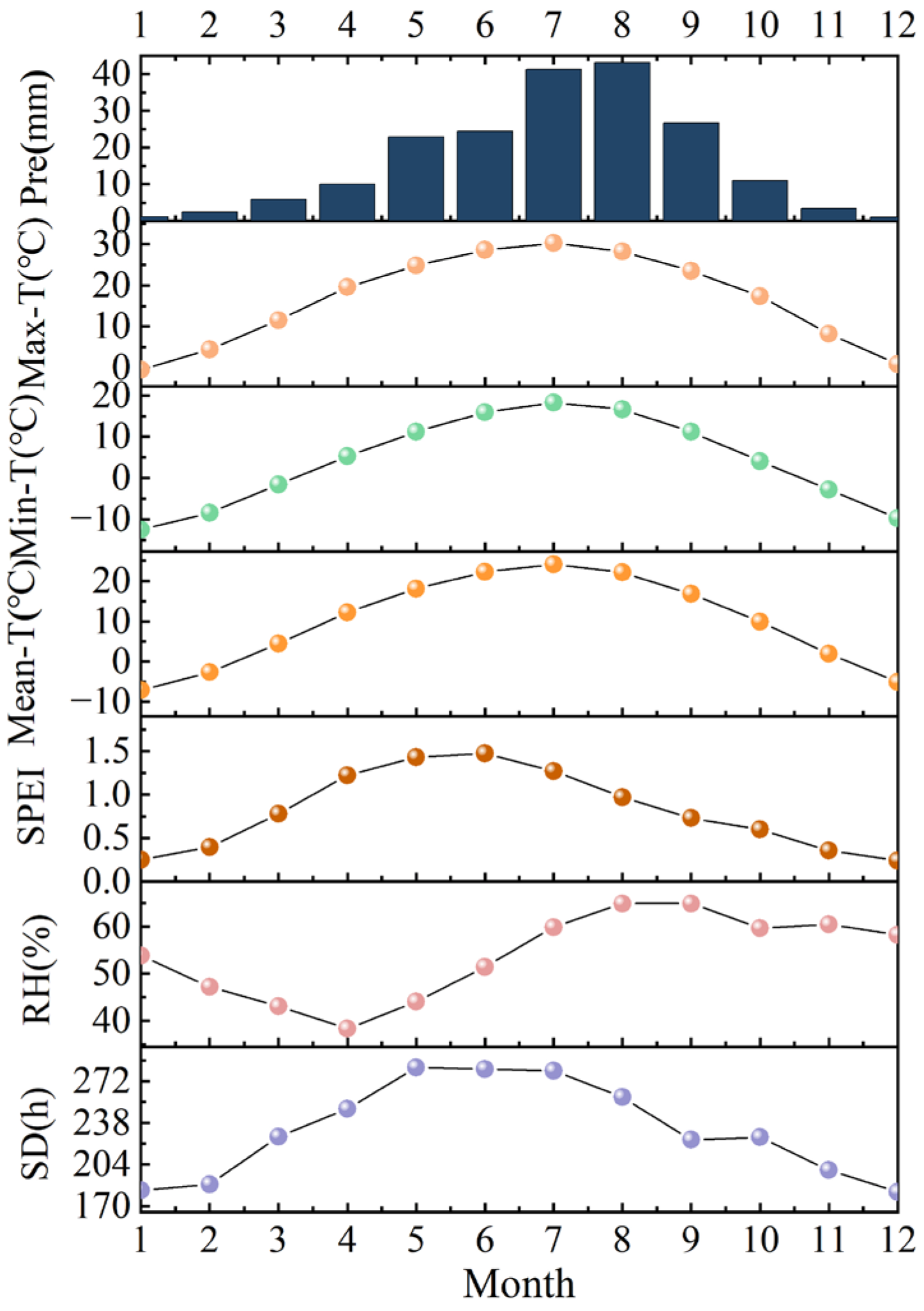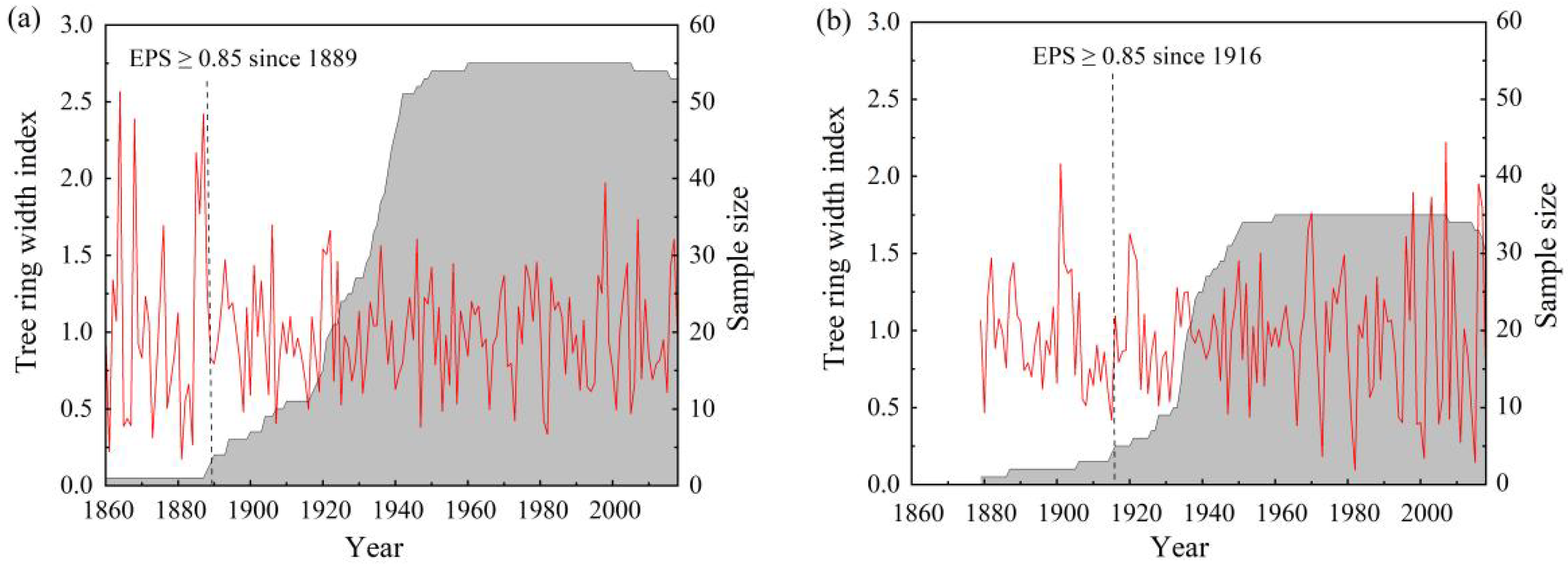Relationship between the Radial Growth of Two Dominant Coniferous Species and GPP in the Arid Region of Northwest China
Abstract
:1. Introduction
2. Material and Methods
2.1. Study Region
2.2. Tree-Ring Data
2.3. GPP Data
2.4. Climate Data
2.5. Data Processing
3. Results
3.1. Characteristics of Tree-Ring Growth
3.2. Response of Tree Rings to GPP
3.3. Response of Tree Rings to Climate
4. Discussion
4.1. Similarities between Spruce and Chinese Pine
4.2. Difference between Spruce and Chinese Pine
5. Conclusions
Supplementary Materials
Author Contributions
Funding
Data Availability Statement
Acknowledgments
Conflicts of Interest
References
- Seftigen, K.; Frank, D.C.; Björklund, J.; Babst, F.; Poulter, B. The climatic drivers of normalized difference vegetation index and tree-ring-based estimates of forest productivity are spatially coherent but temporally decoupled in Northern and tree-ring-based estimates of forest productivity are spatially coherent but temporally decoupled in Northern Hemispheric forests. Glob. Ecol. Biogeogr. 2018, 27, 1352–1365. [Google Scholar] [CrossRef]
- Liu, K.; Zeng, B.; Yang, T.; Jia, L. Analysis of tree ring width index and its relationship with NDVI in Chongqing Qinghua Forestry. Soil Water Conserv. Res. 2015, 22, 170–175. [Google Scholar] [CrossRef]
- Li, M.; Li, G. Relationship between vegetation canopy phenology and trunk formation phenology in the Helan Mountains. J. Appl. Ecol. 2021, 32, 495–502. [Google Scholar] [CrossRef]
- He, J.; Shao, X. Relationships between tree-ring width index and NDVI of grassland in Delingha. Chin. Sci. Bull. 2006, 51, 1106–1114. [Google Scholar] [CrossRef]
- Berner, L.T.; Beck, P.S.A.; Bunn, A.G.; Goetz, S.J. Plant response to climate change along the forest-tundra ecotone in northeastern Siberia. Glob. Chang. Biol. 2013, 19, 3449–3462. [Google Scholar] [CrossRef]
- Zhang, Q.; Liu, Y.; Li, Q.; Sun, C.; Li, T.; Li, P.; Ye, Y. Reconstruction of summer NDVI in Bayinbruck area, central Tianshan Mountain, for the past 339 years based on snowy spruce tree ring width. J. Appl. Ecol. 2021, 32, 3671–3679. [Google Scholar] [CrossRef]
- Li, J.; Wang, S.; Qin, N.; Liu, X.; Jin, L. Vegetation Index Reconstruction and Linkage with Drought for the Source Region of the Yangtze River Based on Tree-ring Data. Chin. Geogr. Sci. 2021, 31, 684–695. [Google Scholar] [CrossRef]
- Wang, W.; Liu, X.; Chen, T.; An, W.; Xu, G. Regional NDVI reconstruction based on tree ring width index in Qilian Mountains. J. Plant Ecol. 2010, 34, 1033–1044. [Google Scholar]
- Xu, P.; Fang, W.; Zhou, T.; Zhao, X.; Luo, H.; Hendrey, G.; Yi, C. Spatial Upscaling of Tree-Ring-Based Forest Response to Drought with Satellite Data. Remote Sens. 2019, 11, 2344. [Google Scholar] [CrossRef] [Green Version]
- Wang, R.; Cheng, R.; Xiao, W.; Feng, X.; Liu, Z.; Wang, X. Relationship between tree ring width and NDVI in northern subtropical Sargassum pine. J. Ecol. 2011, 31, 5762–5770. [Google Scholar]
- Myneni, R.B.; Hall, F.G. The interpretation of spectral vegetation indexes. IEEE Trans. Geosci. Remote Sens. 1995, 33, 481–486. [Google Scholar] [CrossRef]
- Wang, Y.; Xie, Z.; Jia, B.; Yan, Y.U. Simulation and assessment of regional total primary productivity of vegetation in China based on the land surface process model CLM4. Clim. Environ. Res. 2015, 20, 97–110. [Google Scholar]
- Hu, L.; Fan, W.; Ren, H.; Liu, S.; Cui, Y.; Zhao, P. Spatiotemporal Dynamics in Vegetation GPP over the Great Khingan Mountains Using GLASS Products from 1982 to 2015. Remote Sens. 2018, 10, 488. [Google Scholar] [CrossRef] [Green Version]
- Wang, Z. Trend Contribution of Vegetation GPP Changes and Its Attribution Analysis; Nanjing Normal University: Nanjing, China, 2021. [Google Scholar]
- Lin, Y.; Nan, X.; Hu, Z.; Li, X.; Wang, F. Spatial and temporal changes of vegetation cover and its ecological security evaluation in typical ecologically fragile areas in Northwest China: The case of Helan Mountains in Ningxia. J. Ecol. Rural. Environ. 2022, 38, 599–608. [Google Scholar] [CrossRef]
- Liu, Y.; Jiang, Y. Influence of topography on the height of forest line distribution in the high mountains of Helan Mountains. J. Beijing Norm. Univ. (Nat. Sci. Ed.) 2016, 52, 586–590. [Google Scholar] [CrossRef]
- Qin, W.; Meng, W. The father mountain of Ningxia—National Nature Reserve of Helan Mountain. Life World 2021, 10, 4–17. [Google Scholar]
- Liu, B. Changes in soil microbial biomass carbon and nitrogen under typical plant communies along an altitudinal gradient in the east side of Helan Mountain. Ecol. Environ. Sci. 2010, 19, 883–888. [Google Scholar] [CrossRef]
- Liang, C.; Zhu, Z.; Wang, W.; Pei, H.; Zhang, T.; Wang, Y. Diversity of plant community types and their spatial differentiation in Helan Mountain. J. Plant Ecol. 2004, 3, 361–368. [Google Scholar]
- Zhang, S.; Wang, X. Only This Green Is Guarded with Love; Xinhua Daily Telegraph: Beijing, China, 2022. [Google Scholar] [CrossRef]
- Holmes, R.L. Computer-Assisted Quality Control in Tree-Ring Dating and Measurement. Tree-Ring Bull. 1983, 43, 69–78. [Google Scholar]
- Cook, E.; Holmes, R. Users manual for program AR-STAN. Palaeogeogr. Palaeoclimatol. Palaeoecol. 1986, 302, 50–65. [Google Scholar]
- Wigley, T.M.L.; Briffa, K.R.; Jones, P.D. On the Average Value of Correlated Time Series, with Applications in Dendroclimatology and Hydrometeorology. Am. Meteorol. Soc. 1984, 23, 201–213. [Google Scholar] [CrossRef]
- Zheng, Y.; Shen, R.; Wang, Y.; Li, X.; Liu, S.; Liang, S.; Chen, J.M.; Ju, W.; Zhang, L.; Yuan, W. Improved estimate of global gross primary production for reproducing its long-term variation, 1982–2017. Earth SChinese Pinetem Sci. Data 2020, 12, 2725–2746. [Google Scholar] [CrossRef]
- Yuan, W.; Liu, S.; Yu, G.; Chen, J.; Davis, K.; Desai, A.R.; Goldstein, A.H.; Gianelle, D.; Rossi, F.; Suyker, A.E.; et al. Global estimates of evapotranspiration and gross primary production based on MODIS and global meteorology data. Remote Sens. Environ. 2010, 114, 1416–1431. [Google Scholar] [CrossRef] [Green Version]
- Vicente-Serrano, S.M.; Martín-Hernández, N.; Camarero, J.J.; Gazol, A.; Sánchez-Salguero, R.; Peña-Gallardo, M.; El Kenawy, A.; Domínguez-Castro, F.; Tomas-Burguera, M.; Gutiérrez, E.; et al. Linking tree-ring growth and satellite-derived gross primary growth in multiple forest biomes. temporal-scale matters. Ecol. Indic. 2020, 108, 105753. [Google Scholar] [CrossRef]
- Chen, S.; Liu, Y.; Liu, Z.; Cao, L.; Yu, Y.; Yang, Z. Spatial and temporal evolution characteristics of drought in Jinghe River Basin in the past 50 years based on SPEI index. J. Soil Water Conserv. 2022, 36, 181–188+196. [Google Scholar] [CrossRef]
- Wei, T.; Simko, V. R Package “Corrplot”: Visualization of a Correlation Matrix, Version 0.84. 2017. Available online: https://cran.r-project.org/web/packages/corrplot/corrplot.pdf (accessed on 12 October 2022).
- Zang, C.; Biondi, F. Treeclim: An R package for the numerical calibration of proxy-climate relationships. Ecography 2015, 38, 431–436. [Google Scholar] [CrossRef]
- Fritts, H.C. Tree Rings and Climate; Academic Press: New York, NY, USA, 1976. [Google Scholar]
- American Chemical Society. Tree rings and climate. Environ. Sci. Technol. 1995, 29, 392A. [Google Scholar] [CrossRef]
- Hua, Y. Respruceonse of Chinese Pine to Climate and Regional Climate Reconstruction Based on Tree Rings on the North and South Slopes of the Central Qinling Mountains; Northwestern University: Evanston, IL, USA, 2020. [Google Scholar] [CrossRef]
- Ran, Y.; Chen, Y.; Chen, F.; Zhang, R.; Jia, X. May-July NDVI changes in the central Qinling Mountains over the past 194 years as indicated by the tree whorl of Yaoxiong. J. Appl. Ecol. 2021, 32, 3661–3670. [Google Scholar] [CrossRef]
- Wang, H.; Chen, F.; Zhang, R.; Qin, L. Seasonal dynamics of vegetation of the central Loess Plateau (China) based on tree rings and their relationship to climatic warming. Environ. Dev. Sustain. 2017, 19, 2535–2546. [Google Scholar] [CrossRef]
- Li, M.; Li, G. Influence of vegetation type on tree ring reconstruction of NDVI in Helan Mountain. J. Gansu Agric. Univ. 2020, 55, 152–161. [Google Scholar]
- Chen, F.; Yuan, Y.; WEI, W.; Yu, S.; Li, Y.; Zhang, R.; Fan, Z.; Zhang, T.; Shang, H. May-July PDSI changes in northern Helan Mountains recorded by tree ring. Adv. Clim. Chang. Res. 2010, 6, 344–348. [Google Scholar]
- Gao, J.; Yang, B.; He, M.; Shishov, V. Intra-annual variations in climate influence growth and wood density of Norway spruce. Tree Physiol. 2005, 25, 651–660. [Google Scholar] [CrossRef] [Green Version]
- Gao, J.; Yang, B.; He, M.; Shishov, V. Intra-annual stem radial increment patterns of Chinese pine, Helan Mountains, Northern Central China. Trees 2019, 33, 751–763. [Google Scholar] [CrossRef]
- Zaiqin, M.; Yuan, L.; Shengli, J. Study on the relationship between radial growth of forest and climatic factors in the northern edge of China fir. Hubei For. Sci. Technol. 2022, 51, 31–35+90. [Google Scholar]
- Gao, L.; Gou, X.; Deng, Y.; Yang, M.; Zhao, Z.; Cao, Z. Dendroclimatic Response of Picea crassifolia along an Altitudinal Gradient in the Eastern Qilian Mountains, Northwest China. Arct. Antarct. Alp. Res. 2013, 45, 491–499. [Google Scholar] [CrossRef]
- Zhao, S.; He, X.; Zhang, B.; Liu, Q.; Wang, H.; Jiang, Y. Response of radial growth of Qinghai spruce (Picea crassifolia) to climatic factors in an alpine forest line on the eastern slope of Helan Mountains. J. Beijing Norm. Univ. (Nat. Sci. Ed.) 2013, 49, 501–505. [Google Scholar]
- Jiang, Q.; Tian, N.; Xia, T.; Xu, Y.; Lu, F. Research progress on the relationship between temperature, precipitation and radial growth of trees. J. Shandong Agric. Univ. (Nat. Sci. Ed.) 2012, 43, 480–482. [Google Scholar]
- Qin, L.; Shang, H.; Yu, S.; Zhang, H.; Jiang, S.; Zhang, T.; Liu, K.; Gou, X.; Zhang, R. Response of radial growth and water use efficiency of Picea schrenkiana to climate factors in the context of global change. Desert Oasis Meteorol. 2021, 15, 1–9. [Google Scholar]
- Du, M.; Zhang, F.; Gou, X.; Liu, L.; Xia, J.; Wu, X. Differences in response of radial growth of Qinghai spruce to climate warming in the central and eastern parts of the Qilian Mountains. Glacier Permafr. 2022, 44, 14–23. [Google Scholar]
- Wang, Y.; Zhang, Y.; Gou, X.; Gao, L.; Wang, F. Climate response mechanism of radial growth of Qinghai spruce in low altitude areas of the central Qilian Mountains. J. Ecol. 2020, 40, 161–169. [Google Scholar] [CrossRef]
- Fuchs, L.; Stevens, L.E.; Fulé, P.Z. Dendrochronological assessment of springs effects on ponderosa pine growth, Arizona, USA. For. Ecol. Manag. 2019, 435, 89–96. [Google Scholar] [CrossRef]
- Fosu, O.B.; Cook, E.R.; Biasutti, M.; Buckley, B.M.; Nicholson, E.S. The feasibility of reconstructing hydroclimate over West Africa using tree-ring chronologies in the Mediterranean region. Environ. Res. Lett. 2022, 17, 074025. [Google Scholar] [CrossRef]
- Diego, W.; Patrik, K.; Harald, B.; Chiara, M.M.; Martina, P.; Solaria, A.; Marco, C. Silver fir (Abies alba Mill.) is able to thrive and prosper under meso-Mediterranean conditions. For. Ecol. Manag. 2021, 498, 119537. [Google Scholar] [CrossRef]
- Gazol, A.; Camarero, J.J.; Sánchez-Salguero, R.; Vicente-Serrano, S.M.; Serra-Maluquer, X.; Gutiérrez, E.; de Luis, M.; Sangüesa-Barreda, G.; Novak, K.; Rozas, V.; et al. Drought legacies are short, prevail in dry conifer forests and depend on growth variability. J. Ecol. 2020, 108, 2473–2484. [Google Scholar] [CrossRef]
- Gao, L.; Gou, X.; Deng, Y.; Liu, W.; Yang, M.; Zhao, Z. Climate-growth analysis of Qilian juniper across an altitudinal gradient in the central Qilian Mountains, northwest China. Trees 2013, 27, 379–388. [Google Scholar] [CrossRef]
- Liang, H.; Jiang, S.; Ali, M.; Kang, J.; Zhu, H.; Li, X.; Chen, L.; Zhu, L.; Huang, J. Radial Growth Response of Picea crassifolia to Climatic Conditions in a Dryland Forest Ecosystem in Northwest China. Forests 2021, 12, 1382. [Google Scholar] [CrossRef]
- Huang, J.-G.; Annie, D.; Sergio, R. Xylem formation can be modeled statistically as a function of primary growth and cambium activity. New Phytol. 2014, 203, 831–841. [Google Scholar] [CrossRef] [PubMed]
- Wang, Y.; Ma, Y.; Zheng, Y.; Lu, R.; Sang, Y.; Meng, H. Response of tree-ring width of Pinus tabulae for mis to climate factors in Luoshan Mountains of Ningxia. Desert China 2009, 2, 971–976. [Google Scholar]
- Wang, Z.; Yang, B.; Deslauriers, A.; Bräuning, A. Intra-annual stem radial increment response of Qilian juniper to temperature and precipitation along an altitudinal gradient in northwestern China. Trees 2015, 29, 25–34. [Google Scholar] [CrossRef]







| Tree-Ring Width (Mean ± Standard Deviation) (mm) | Correlation Coefficients between Cores | Standard Deviation | Mean Sensitivity | Expressed Population Signal | Variance in First Eigenvector | |
|---|---|---|---|---|---|---|
| spruce | 0.98 ± 0.72 | 0.718 | 0.426 | 0.432 | 0.993 | 73.0% |
| Chinese pine | 1.09 ± 0.84 | 0.474 | 0.406 | 0.465 | 0.965 | 59.6% |
Disclaimer/Publisher’s Note: The statements, opinions and data contained in all publications are solely those of the individual author(s) and contributor(s) and not of MDPI and/or the editor(s). MDPI and/or the editor(s) disclaim responsibility for any injury to people or property resulting from any ideas, methods, instructions or products referred to in the content. |
© 2023 by the authors. Licensee MDPI, Basel, Switzerland. This article is an open access article distributed under the terms and conditions of the Creative Commons Attribution (CC BY) license (https://creativecommons.org/licenses/by/4.0/).
Share and Cite
Liu, N.; Wu, Z.; Du, Z.; Lei, T.; Sun, B. Relationship between the Radial Growth of Two Dominant Coniferous Species and GPP in the Arid Region of Northwest China. Forests 2023, 14, 1336. https://doi.org/10.3390/f14071336
Liu N, Wu Z, Du Z, Lei T, Sun B. Relationship between the Radial Growth of Two Dominant Coniferous Species and GPP in the Arid Region of Northwest China. Forests. 2023; 14(7):1336. https://doi.org/10.3390/f14071336
Chicago/Turabian StyleLiu, Na, Zhitao Wu, Ziqiang Du, Tianjie Lei, and Bin Sun. 2023. "Relationship between the Radial Growth of Two Dominant Coniferous Species and GPP in the Arid Region of Northwest China" Forests 14, no. 7: 1336. https://doi.org/10.3390/f14071336
APA StyleLiu, N., Wu, Z., Du, Z., Lei, T., & Sun, B. (2023). Relationship between the Radial Growth of Two Dominant Coniferous Species and GPP in the Arid Region of Northwest China. Forests, 14(7), 1336. https://doi.org/10.3390/f14071336







